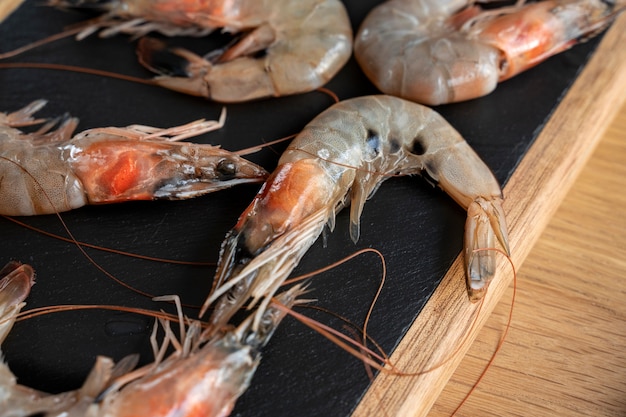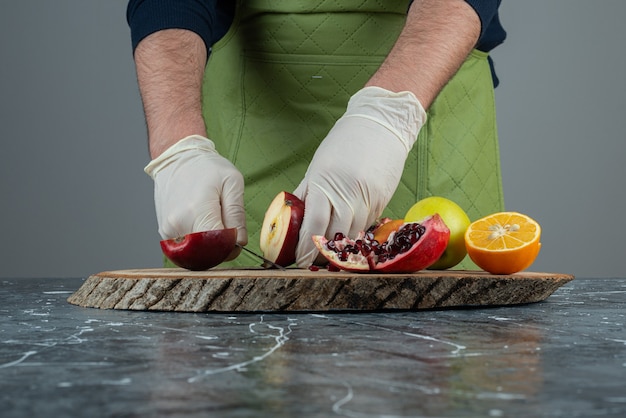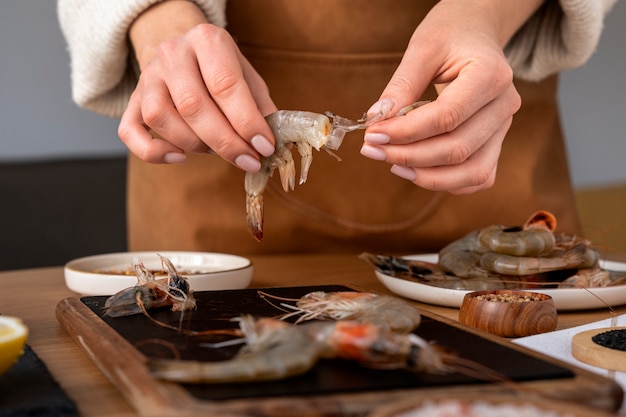Let me tell you, cooking lobster can feel a bit daunting at first. My first attempt, well, let's just say it wasn't exactly Michelin-star worthy. But I've learned a lot since then, and now I can confidently say that anyone can cook a delicious lobster, even if you've never tackled a crustacean before. This guide is your roadmap to lobster perfection, taking you from the fishmonger to the table with all the tips and tricks you need to impress your guests (or just yourself!).
Part 1: Choosing the perfect lobster

The first step to a fabulous lobster dish is selecting the right one. Think of it as choosing a partner for a dance—you want someone lively, vibrant, and full of flavour! Here's what to look for:
Size Matters, But So Does Freshness:
Generally, a 1-1.5 pound lobster is a perfect portion for one person. For a larger crowd, you can scale up to 2-3 pounds or even bigger! But size isn't everything—freshness is key. You want a lobster that's lively and active. If it's sluggish or lying on its back, it might be past its prime. The shell should be firm and smooth, without any cracks or signs of damage.
Always opt for fresh lobster whenever possible. If you're buying live, make sure it's in a tank of clean, circulating water. Avoid lobsters that are stored on ice—they can become stressed and lose their delicate flavour. If you're unsure, ask your fishmonger for advice. They're experts in seafood and can guide you towards the freshest, most flavourful lobster you can find.
Part 2: Prepping the Lobster - It's All About Safety

You've got your lobster, now it's time to prepare it for cooking. Don't be intimidated—it's actually quite simple! The key here is safety. We don't want any unwanted pinches, right?
Handling with Care:
1. The Banding: First things first, you need to remove the rubber band holding the lobster's claws together. This is essential for safety—you don't want a snapping claw causing any accidents! 2. Rinse and Chill: Rinse the lobster under cold running water to remove any debris. If you have some time, chill the lobster in the refrigerator for an hour or two. This will calm it down and make it easier to handle.
Part 3: Cooking the Lobster - Your Choice of culinary adventure

There are so many ways to cook lobster, each with its own unique charm and flavour profile. Let's explore some of the most popular methods and their secrets:
Steaming: The Gentle Giant
Steaming is a fantastic way to cook lobster gently, preserving its delicate flavour and natural sweetness. It's like giving your lobster a soothing spa treatment, but with an incredible culinary result. Here's how to steam like a pro:
Step-by-Step:
- Fill a large pot with about two inches of water. Add a handful of salt to season the water, and for an extra touch of flavour, throw in a few bay leaves or sprigs of thyme. Bring it to a rolling boil.
- Place a steamer basket inside the pot, making sure it sits above the boiling water. This ensures your lobster is enveloped in steam, not submerged.
- Gently place the lobster in the steamer basket and cover the pot. Steam for about 12-15 minutes, depending on the size of the lobster. You'll know it's done when the lobster turns a brilliant red colour, and the meat is opaque and firm to the touch.
- Carefully remove the lobster from the steamer basket using tongs and let it cool slightly before serving.
Boiling: The Classic Method
Boiling is a classic method that produces a tender and flavorful lobster. It's simple, straightforward, and delivers consistently delicious results. Here's how to boil like a pro:
Step-by-Step:
- Fill a large pot with enough water to cover the lobster completely. Add salt to season the water, and feel free to add aromatics like bay leaves, peppercorns, or lemon slices for an extra flavour boost. Bring the water to a rolling boil.
- Carefully add the lobster to the pot and reduce the heat to a simmer. Cook for about 10-12 minutes, depending on the size of the lobster. The lobster will turn a vibrant red when it's cooked through.
- Remove the lobster from the pot using tongs and let it cool slightly before serving.
Grilling: For a Smoky Kiss of Flavor
Grilling adds a smoky flavour to your lobster, making it a real showstopper. Just be sure to use a high-heat grill to get that beautiful char. Here's how to grill like a pro:
Step-by-Step:
- Preheat your grill to high heat. For gas grills, preheat the burner for about 15 minutes. For charcoal grills, let the coals burn down until they are covered in white ash.
- Split the lobster in half lengthwise, using a sharp knife. Then, remove the digestive tract (also known as the "sand vein") along the underside of the tail. This will make the meat more appealing and prevent any unpleasant flavours.
- Brush the lobster halves with melted butter or olive oil, and season generously with salt, pepper, and any other herbs and spices you enjoy. Remember, a little goes a long way!
- Place the lobster halves on the preheated grill, flesh side down. Cook for about 4-6 minutes per side, or until the meat is opaque and cooked through. You want a nice char, but not burnt.
- Remove the lobster from the grill and serve immediately. It's best enjoyed hot and fresh.
Baking: For a Hands-Off Approach
Baking is a great option if you prefer a more hands-off approach to cooking lobster. You can bake it whole or split it in half, but the results are always impressive. Here's how to bake like a pro:
Step-by-Step:
- Preheat your oven to 400°F (200°C).
- Place the lobster in a baking dish and brush it with melted butter or olive oil. Season generously with salt, pepper, and your favorite herbs and spices. A little garlic powder, paprika, or even a pinch of cayenne pepper can add a delightful kick.
- Bake for 15-20 minutes, or until the lobster is cooked through and the meat is opaque. You can check the internal temperature with a meat thermometer—it should reach 140°F (60°C).
- Remove the lobster from the oven and let it cool slightly before serving.
Part 4: Serving the Lobster - A Feast for the Senses
Now that you've cooked your lobster to perfection, it's time to showcase its beauty and flavour! Here's how to serve it with style:
Presentation is Key:
A beautifully presented lobster is a feast for the eyes and the palate. Use a platter or individual plates and arrange the lobster with care, like a piece of art. Don't forget to add garnishes! A sprinkle of fresh parsley, a lemon wedge, or even a few sprigs of dill can add a touch of elegance and freshness.
Accompanying Delights:
Lobster pairs beautifully with a variety of sides and sauces, enhancing its flavour and creating a truly memorable meal. Here are some classic options:
side dishes:
- Steamed Vegetables: Asparagus, broccoli, carrots, and corn are all excellent companions for lobster, offering a vibrant contrast in texture and flavour.
- rice pilaf: A simple rice pilaf with herbs and butter is a delicious way to soak up the lobster's juices, creating a satisfying and flavorful combination.
- Potatoes: mashed potatoes, roasted potatoes, or potato salad are all wonderful additions to a lobster meal, offering a comforting and familiar base for the luxurious lobster.
Sauces:
- Melted Butter: This is a classic pairing for lobster, offering a rich and decadent flavour. You can also add garlic, lemon juice, or herbs to the melted butter for extra flavour. A touch of lemon zest can elevate the buttery richness with a bright citrus note.
- Lemon Butter Sauce: A bright and tangy sauce made with lemon juice, butter, and herbs. It's a great way to add a touch of freshness to your lobster, cutting through the richness with a burst of citrus.
- Garlic Butter Sauce: A rich and aromatic sauce made with garlic, butter, and herbs. It's a perfect complement to the lobster's flavour, adding a warm, savory depth. A sprinkle of chopped parsley adds a finishing touch of freshness and vibrancy.
Part 5: Cracking the Lobster - A Culinary Adventure
Here comes the fun part—cracking open your lobster and enjoying those succulent morsels of meat! But let's be honest, it can be a bit tricky at first. Here are some pointers to help you become a lobster-cracking pro:
Cracking the Claws:
Use a lobster cracker to break the claws. If you don't have a cracker, you can use a heavy knife, but be careful! Hold the claw firmly and crack it in the middle. Twist the pieces apart to expose the meat inside. Don't be afraid to apply a little force—this is part of the fun!
Splitting the Tail:
Use a sharp knife to cut down the centre of the tail. You can then separate the two halves and remove the meat from the shell using a fork. Don't forget to remove the dark, intestinal vein along the underside of the tail. This is a bit of a "delicate" task, but it's important for flavour and aesthetics.
The Knack for Legs:
The legs can be tricky, but with a bit of practice, you'll be a pro! Use your fingers to twist the legs at the joint, then pull the meat out with a fork. You can also use a small knife to help you remove the meat from the leg. The key here is patience and a little finesse—don't be afraid to try different techniques until you find one that works for you.
Part 6: Extracting the Meat - The Jewels of the Lobster
Once you've cracked and split your lobster, it's time to enjoy the fruits of your labour! Here's how to extract all that delicious meat, ensuring you get every last morsel:
Claw Meat:
The claw meat is the most prized part of the lobster. It's tender, juicy, and packed with flavour. Use a fork to extract the meat from the claw, taking care not to tear it. You can also use a small spoon to scoop out the meat, especially if it's a bit stubborn.
Tail Meat:
The tail meat is another delicacy. Use a fork to gently remove the meat from the shell. Be careful not to tear the meat—this is where a bit of finesse comes in handy! You can also use a small spoon to extract the meat from the tail, especially near the end where it tends to be more delicate.
Leg Meat:
The leg meat is a bit more challenging to extract, but it's well worth the effort. Use a fork to pull the meat out of the leg. You can also use a small knife to help you remove the meat from the leg, especially if it's stuck. Don't be afraid to experiment with different techniques—you might even discover a new trick that makes the process easier!
Part 7: The Art of Eating Lobster - A Sensory Experience
Eating lobster is an experience—a tactile one, a delicious one, and a social one! It's a symphony of textures and flavours that should be savoured. Here's how to navigate this culinary adventure with grace and gusto:
Lobster Etiquette:
While there's no strict etiquette for eating lobster, there are some common practices to keep in mind. It's a casual affair, so relax and enjoy!
- Use your hands: It's perfectly acceptable to use your hands to crack the lobster and extract the meat. In fact, it's often considered the most satisfying way to enjoy it.
- Don't be afraid to get messy: Lobster can be a bit messy, but that's all part of the fun! Embrace the experience and enjoy the deliciousness.
- Save the shell: Traditionally, the lobster shell is used as a bowl for the melted butter. It's a fun and rustic touch that adds to the experience, allowing you to savor every last drop of that rich, buttery goodness.
Enjoying the Experience:
Eating lobster is an experience that's meant to be savoured. Take your time, enjoy the flavour of the meat, and appreciate the artistry of this culinary delight. Don't hesitate to try different dipping sauces and side dishes to enhance the experience. It's all about finding the perfect balance of flavours and textures that appeal to your palate.
Part 8: Leftover Love - Making the Most of Lobster Bliss
Let's be honest, sometimes you end up with a bit of leftover lobster, and it's simply too delicious to waste! Here are some ideas to make the most of those delicious scraps and create even more lobster-filled delights:
Lobster Salad: A Classic with a Twist
Combine leftover lobster meat with mayonnaise, celery, onion, and herbs to create a classic lobster salad. You can serve it on sandwiches, crackers, or lettuce leaves for a light and refreshing meal. For an extra burst of flavour, add a squeeze of lemon juice or a drizzle of hot sauce.
lobster bisque: Rich, Creamy, and Delicious
Use leftover lobster shells to make a rich and flavourful lobster bisque. Simply simmer the shells with vegetables and spices in broth to create a delicious base. Then blend it smooth and add cream for a creamy bisque. The flavour of the lobster shells will infuse the bisque with a deep, savoury depth. You can garnish it with a dollop of cream, a sprinkle of chopped parsley, and a few drops of hot sauce for a fiery finish.
Lobster Pasta: A quick and easy meal
Add leftover lobster meat to your favourite pasta dish for a quick and delicious meal. You can toss it with pasta, garlic, and olive oil for a simple and satisfying dish, or add it to a creamy tomato sauce for a richer, more complex flavour.
lobster mac and cheese: A Luxurious comfort food
For a luxurious twist on a classic comfort food, add leftover lobster meat to your mac and cheese. It's an unexpected and delicious combination that everyone will love. The rich, creamy mac and cheese provides a perfect base for the delicate flavour of the lobster. You can add a sprinkle of breadcrumbs on top and bake it in the oven for a golden-brown crust.
FAQs:
1. How long can I store live lobster?
Live lobsters should be stored in a cool, moist environment. They can be kept in a refrigerator for up to 24 hours, but it's best to cook them as soon as possible to preserve their freshness and flavour. The longer you store them, the more likely they are to lose their vitality and become less palatable.
2. How do I know if a lobster is cooked?
A cooked lobster will turn a bright red colour and the meat will be opaque. The flesh will also be firm and springy to the touch, not soft or mushy. You can also check the internal temperature of the lobster with a meat thermometer. The internal temperature should reach 140°F (60°C).
3. What is the best way to store leftover lobster?
Store leftover lobster in an airtight container in the refrigerator. It will stay fresh for up to 3 days. You can also freeze leftover lobster for up to 3 months. Thaw it in the refrigerator overnight before using it. It's best to use frozen lobster in dishes where it will be cooked through, such as soups, stews, or pasta dishes.
4. Can I cook lobster from frozen?
Yes, you can cook lobster from frozen, but it will take longer than cooking fresh lobster. Simply defrost the lobster completely in the refrigerator before cooking. Add extra cooking time to the recipe to ensure that the lobster is cooked through. Keep in mind that the texture and flavour of frozen lobster may be slightly different from fresh lobster.
5. What are some tips for eating lobster with good manners?
While there are no strict rules, it's generally considered good manners to use your hands to crack the lobster. Don't be afraid to get messy! It's also a good idea to save the shell for dipping the melted butter. And most importantly, enjoy the experience! Lobster is a delicacy that should be savoured, and a bit of friendly banter about the best way to extract the meat is all part of the fun.
Everyone is watching

Perfect Rice Every Time: The Ultimate Guide to Cooking Rice
Cooking TipsAs a self-proclaimed foodie, I've always been a bit obsessed with rice. It's the foundation of countless cuisi...

Prime Rib Roast Cooking Time Chart: Per Pound Guide
Cooking TipsPrime rib roast. Just the name conjures images of lavish dinners, crackling fires, and hearty laughter. It’s ...

How Long to Bake Potatoes in the Oven (Perfect Every Time)
Cooking TipsBaked potatoes are a staple in my kitchen. They're incredibly versatile, delicious, and surprisingly easy to m...

The Ultimate Guide to Cooking Asparagus: Tips, Techniques, and Recipes
Cooking TipsAsparagus. The mere mention of this spring delicacy conjures up images of vibrant green spears, crisp and burs...

Ultimate Guide to Cooking the Perfect Thanksgiving Turkey
Cooking TipsThanksgiving. Just the word conjures up images of overflowing tables laden with delicious food, the scent of r...
